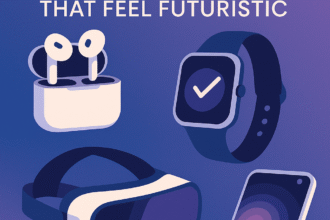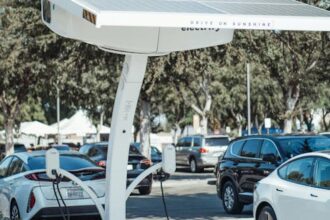Mobile technology evolves in waves. Each generation brings faster speeds, lower latency, and new possibilities that shape how we communicate, work, and interact with the world around us. Over the last few years, 5G has made its mark by enabling ultra-fast downloads, cloud gaming, and smart city innovations. But just as 5G is becoming mainstream, the tech world is already buzzing about 6G, the next generation of wireless connectivity expected to arrive by the end of this decade.
So, what does this leap from 5G to 6G actually mean for you? Let’s explore the differences, the promises, and the real-world implications of the next wave of mobile technology.
The Journey So Far: From 3G to 5G
Before diving into the comparison between 5G and 6G, it helps to look at the evolution of mobile networks:
- 3G brought us mobile internet and the ability to browse the web on our phones.
- 4G LTE introduced fast streaming, app ecosystems, and mobile-first lifestyles.
- 5G built on that by offering blazing speeds, near-zero latency, and the backbone for innovations like autonomous vehicles and smart factories.
Each generation has been about more than just speed. It has unlocked new industries and reshaped daily life. Now, with 6G on the horizon, the potential is even more transformative.
What Makes 5G Different?
When 5G networks rolled out, the promise was clear: a leap forward in speed and reliability. And it delivered.
- Speed: Average download speeds of 100 Mbps to 10 Gbps depending on location and network infrastructure.
- Latency: As low as 1 millisecond, enabling real-time responsiveness for applications like cloud gaming or autonomous driving.
- Capacity: Ability to connect millions of devices simultaneously, crucial for the Internet of Things (IoT).
For consumers, this meant smoother video calls, instant movie downloads, and seamless mobile gaming. For industries, it created the backbone for remote surgery, smart cities, and connected logistics.
Enter 6G: A Quantum Leap in Connectivity
While 5G is still expanding globally, research on 6G networks is already well underway. Countries like South Korea, China, and the U.S. are investing billions in R&D, with early testbeds showing astonishing results.
6G is expected to offer:
- Speeds up to 1 Tbps (terabit per second) — roughly 100 times faster than 5G.
- Latency under 100 microseconds, making interactions feel instant.
- Holographic communication, real-time digital twins, and immersive extended reality (XR) as everyday experiences.
The focus of 6G isn’t just speed; it’s about seamless integration between the physical, digital, and biological worlds. Imagine wearing AR glasses that overlay real-time translations during a meeting, or doctors using digital twins of patients for remote, AI-assisted surgeries.
Everyday Benefits: How 5G Helps You Now
For many people, the impact of 5G is already tangible. Everyday benefits include:
- Faster streaming: Ultra-HD and 8K videos without buffering.
- Mobile gaming: Cloud gaming platforms run smoothly with low latency.
- Work on the go: High-speed video conferencing and collaboration tools anywhere.
- Smarter homes: IoT devices connect more reliably, from thermostats to security systems.
While 5G may not feel revolutionary for everyone yet, its real strength lies in how it enables the technologies around us to perform better.
Everyday Benefits: What 6G Could Bring
6G will take things to a whole new level. Here’s how it could transform daily life:
- Holographic calls: Instead of flat video, imagine realistic 3D holograms of your friends and colleagues appearing in your living room.
- Real-time language translation: Conversations across different languages happening seamlessly through AR glasses or earbuds.
- Extended reality workspaces: Immersive virtual offices where collaboration feels like being physically present.
- Healthcare monitoring: Wearables that send real-time biometric data to AI-driven health systems, enabling early detection of illness.
In other words, 6G could make science fiction experiences part of everyday life.
Industry Impact: 5G in Action
Industries have already started leveraging 5G in impactful ways:
- Manufacturing: Smart factories use 5G for machine-to-machine communication, improving efficiency and reducing downtime.
- Healthcare: Remote surgeries with robotic assistance have been tested thanks to low-latency 5G connections.
- Automotive: Self-driving cars rely on 5G for communication between vehicles and smart infrastructure.
The industrial applications of 5G are where the technology truly shines—enabling real-time data processing and safer automation.
Industry Impact: The 6G Revolution
If 5G laid the foundation, 6G could build the skyscraper. Industries are expected to see even greater changes:
- Smart cities: Real-time management of traffic, energy, and public safety using predictive AI.
- Healthcare: Digital twins of patients allow doctors to simulate treatments before real-world application.
- Education: Immersive classrooms with AR/VR creating hands-on experiences across the globe.
- Finance: Instant, ultra-secure transactions powered by quantum-safe encryption.
The potential productivity and innovation gains from 6G are enormous, reshaping nearly every sector.
The Technical Differences: Under the Hood
5G Technologies
- Millimeter waves: Higher frequency spectrum for faster speeds.
- Massive MIMO (Multiple Input, Multiple Output): More antennas on base stations for better coverage.
- Beamforming: Directing signals for stronger connections.
6G Technologies
- Terahertz frequencies: Even higher frequency bands for unprecedented speed.
- AI-native networks: Networks that optimize themselves using machine learning.
- Quantum communication: Advanced encryption for security.
These differences highlight why 6G won’t just be an upgrade—it will be a fundamental shift in how networks are designed and used.
Challenges Ahead for 5G
Despite its advantages, 5G isn’t without challenges:
- Coverage gaps: Rural areas still struggle with reliable access.
- High costs: Infrastructure rollout is expensive.
- Device compatibility: Not all devices support full 5G capabilities.
For many, these hurdles have slowed adoption. But as networks expand and costs drop, 5G will become more universally accessible.
Challenges Ahead for 6G
If 5G’s challenges are significant, 6G’s are monumental:
- Infrastructure demands: Building terahertz networks will require new materials and energy solutions.
- Regulation: Global coordination on standards is complex.
- Accessibility: Ensuring that 6G doesn’t widen the digital divide will be critical.
While the technology is exciting, the path to everyday use will take years of collaboration and investment.
What This Means for You as a Consumer
In practical terms, here’s how this plays out:
- 5G today: Enjoy faster speeds, smoother streaming, and more reliable connectivity.
- 6G tomorrow: Prepare for immersive, AI-driven experiences that blend physical and digital realities.
Think of 5G as the smartphone era going mainstream, while 6G will feel like stepping into a fully connected, augmented world.
Timeline: When Will You See 6G?
- 2025: Continued global rollout of 5G.
- 2028–2030: Early pilot projects for 6G.
- 2030–2035: Widespread consumer adoption of 6G technology.
For now, 5G is the reality, and 6G remains a glimpse of the near future.
The leap from 5G to 6G isn’t just about faster internet—it’s about fundamentally reshaping human experiences and industries. 5G is already making our lives more connected and efficient, while 6G promises to merge the digital and physical worlds in ways we’re only beginning to imagine.
For the everyday user, this means more convenience, better communication, and entirely new ways of living, learning, and working. For industries, it means unprecedented efficiency, innovation, and growth. As with every wave of mobile technology, the most exciting part isn’t just what it can do—it’s what it will inspire us to create.
Key Takeaways
- 5G is here now, delivering faster speeds and enabling smarter industries.
- 6G will be 100x faster, with near-instant latency and immersive XR experiences.
- Everyday benefits of 5G include better streaming, gaming, and connectivity.
- Everyday benefits of 6G will include holographic calls, real-time translations, and digital twins.
- Challenges remain: Coverage, cost, and regulation will shape adoption timelines.
- Timeline: 6G is expected to roll out between 2028 and 2035.








